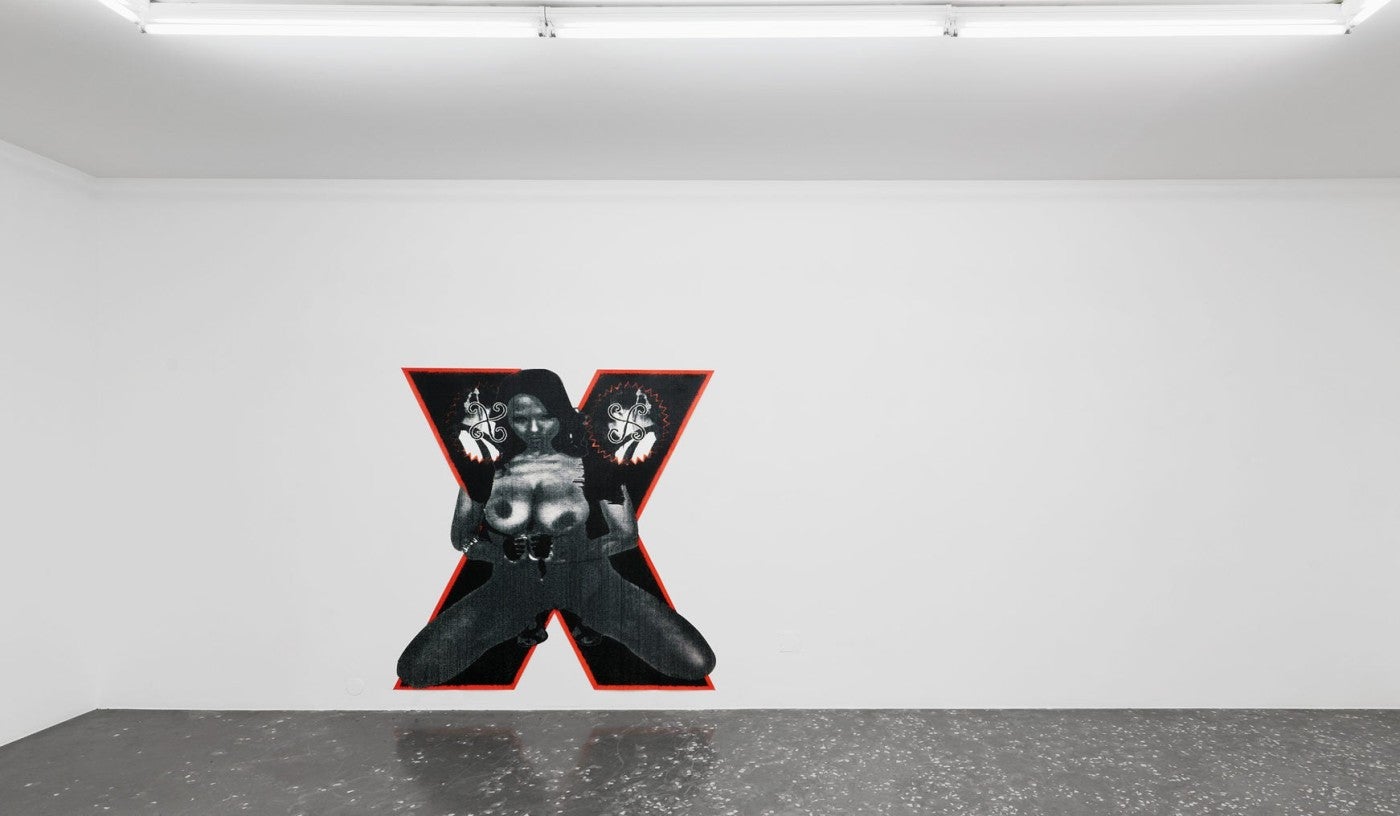Transfiguration

Darja Bajagić solo show.
If the doors of perception were cleansed every thing would appear to man as it is, Infinite Dominno is a recurrent figure in the work of Darja Bajagić, black hair, dark look, this Czech pornographic actress and muse of the artist is not affected by the indifference of her contemporaries. In Transfiguration (2019), her face is erased and coexists with the juvenile face of Hanna Cuna, a photograph from long ago (1945), an irreducible sign of recognition of a child deported during the Second World War in the village of Kloster Indersdorf in the Bayern area, published in a local newspaper. This face is circled by a heraldic symbol, a solar signal referring to transfiguration, a process of complete change of form or appearance into a more beautiful or spiritual state. This composition in the form of a shield protects and conceals
while adorning itself with declarative virtues. It states a lineage: historical, symbolic, iconographic– becomes an index table to find the sons. In Ultimate Reality (2019), Dominno is more frontal, her chest swollen by the cut of a t-shirt that is too tight, her thorax is in the center of a Saint-Andrew’s cross, the cross of tortured people and the typical X indicating a pornographic site. Her shoulders are surmounted by the faded photographs of a woman having committed suicide by hanging that appeared in the Mexican murderabilia magazine Alarma (1963), today defunct and collected by the artist.
The face is jerky, grayish, damaged by multiple reprints. Superimposed on her are the symbols of a neo-Gnostic cult (dated between the X and XV century) known by the name of Bogomil that operated in the Balkans. This sect based
on a dual cosmology claimed that the visible world was the product of the Devil where salvation existed only after death. Is the material world intrinsically violent or, as William Blake says, “a path dug out of abysses, populated with wild animals and snakes”? A duplicity in the heart of Makoš (X) (2019), or Mokosh, a Slavic goddess of rain and storm, protector of women and dealing with fertile fates or fatal destinies. Her symbol sits on top of the photograph of children deported to the Jastrebarsko camp by the Ustasha, a Croatian anti-Yugoslav pro-Nazi political party. Their faces can barely be seen, made powerless by the by the intent to kill of this fascist movement of the ‘30s. The power given to the gods is here transfigured by the hand of Man, violence is extricated from the invisible for the visible world. In Hexagon
(Intolerable Dominnation) (2019), Dominno is half-kneeling down in a conquering pose in the center of a frame resembling an altar, the place of the offering and the sacrifice. The iconoclastic ambivalence of this confrontation is replayed by the whirlwind that seems to absorb her and drag her body into nothingness.
Is this tumultuous interweaving of meaning and form between religiosity, iolence and desire not likely to lead to paranoia? Or worse paranoia of paranoia? The paralysis to produce an image, to transfigure it precisely, in light of the dangerously unforeseen consequences coming under the scrutiny of the interpretation? Or perhaps, as the super-villain in the film Strange Days (Kathryn Bigelow, 1995) puts it, “is paranoia not but a finer way of grasping reality?” Never ceasing to question the accursed part of the image, Darja Bajagić’s work is unique in that it resists the hermeneutic and erotic categories of their receptions. The signs gleaned from various sources refer to fields and regimes of images with contradictory interests: liturgical, orthodox, pagan, hermetic symbols, collective memory photography, counter-cultural
fetishes, Gothic, porn or horror. They circulate, load and discharge themselves of meanings according to the context, regain their vitality or are anesthetized but remain recalcitrant to univocity. Her procedures borrow as much from a
modernism in search of objectivity (flattening the sign, reductionism of the form, a minimalist chromatic palette, appropriating the image) as from their own mythology. In this set of stories, of divine, human or monstrous figures,
Wittgenstein’s formula applies: “the meaning of a word is its use in language”, here touching on the unresolved enigma.
And that’s where the rub comes in and irritates or fascinates you. Between realities and representations, her both plane and solid figures oscillate between the famous adage What you see is what you get, left in unsolved parentheses, and the indescribable images, Against Interpretation.
Pierre-Alexandre Mateos & Charles Teyssou